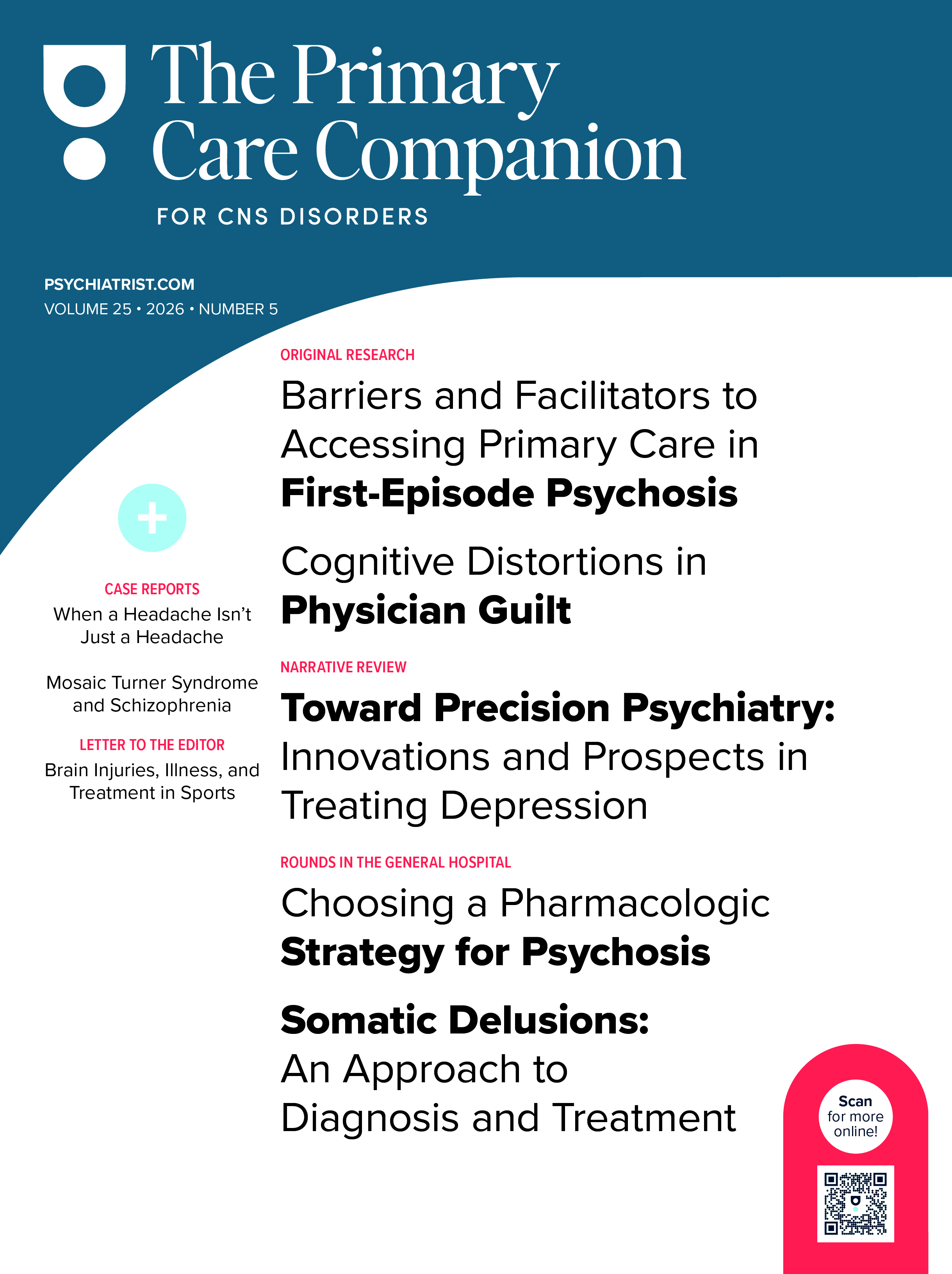Cushing syndrome (CS) is a rare clinical condition resulting in excess cortisol production. Neuropsychiatric disturbances are prevalent, in addition to the well-known metabolic effects. Depression and anxiety are the most common manifestations, while mania and psychosis are rare.1,2 We report the case of a patient who presented with severe psychosis due to adrenocorticotropic hormone (ACTH)–dependent CS due to a pituitary adenoma (PA).
Case Report
A 47-year-old woman was brought to the hospital after she was found wandering on someone’s property 2 days after her parents had filed a missing person report. She was disoriented, had difficulty recalling events, and reported intrusive thoughts. She had a history of hypertension, hyperlipidemia, prediabetes, and schizoaffective disorder diagnosed 10 years ago when she had an episode of acute psychosis. She was noncompliant with her medications.
On presentation, her blood pressure was 160/111 mm Hg, pulse rate was 111 bpm, and body mass index was 24.14 kg/m2. The psychiatric examination revealed disorientation, thought disorganization, subdued mood, blunted affect, and impaired memory and attention. She had central adiposity and coarse terminal hair growth on her chin; the rest of the physical examination was unremarkable. She was started on olanzapine but developed catatonia after 10 days. Olanzapine was discontinued after 4 weeks as her catatonia worsened. Due to the worsening of hypertension, her random cortisol level was checked and found to be elevated at 51.8 μg/dL (2.9–19.4 μg/dL). Further workup was deferred due to testing difficulty in the setting of acute psychosis. A trial of aripiprazole was initiated but was discontinued after 10 days due to the persistence of catatonia. She then received electroconvulsive therapy on alternate days for 11 sessions, with improvement in her symptoms.
The workup of CS was initiated due to the difficulty in managing her symptoms, weight gain, worsening of hypertension, and pedal edema. Laboratory investigations showed potassium of 2.7 mEq/dL (3.5–5.5 mEq/dL), elevated serum cortisol of 39.3 μg/dL (2.9–19.4 μg/dL), and ACTH of 100.2 pg/dL (7.2–63.3 pg/dL). Her 24-hour urinary free cortisol level was 2,340 and 1,180 (≤45 μg/dL) on 2 separate occasions, thyroid-stimulating hormone was 0.02 (0.4–4.0 mIU/L), and free thyroxine was 0.6 (0.7–1.9 ng/dL). The dexamethasone suppression test was also abnormal. Given that her ACTH level was elevated, there was a high concern for a PA. A magnetic resonance imaging scan revealed a 9.3 x9.6–mm nonenhancing focus on the posterior aspect of the pituitary, which confirmed the diagnosis of ACTH-dependent CS. Central hypothyroidism was attributed to the mass effect of the PA. Transsphenoidal PA resection was performed with subsequent improvement in her symptoms.
Discussion
Acute psychosis may be the initial manifestation of CS. This can easily be overlooked, especially in patients with preexisting psychiatric conditions. CS can be indolent, with clinical and neuropsychiatric features often beginning years before diagnosis. In this case, the initial presentation a decade ago could also be attributed to CS. Many antipsychotic drugs can result in metabolic syndrome, which can be hard to differentiate from manifestations of CS.3 Individuals with neuropsychiatric disorders can have elevation in their cortisol levels due to activation of the hypothalamic-pituitary axis, especially in the evening, without the presence of any pituitary or adrenal adenomas (these result in pathological hypercortisolism).4 This is known as pseudo-CS or physiological hypercortisolism.5 Based on clinical features alone, physiological and pathological hypercortisolism can be hard to distinguish. A high index of clinical suspicion is needed, with repeat testing often required, as there are no specific cutoffs to distinguish between these conditions.6,7
In patients with severe neuropsychiatric illness and features of metabolic syndrome, a diagnosis of CS should be strongly considered, especially in those not responding to conventional treatment strategies. Early recognition and treatment can lead to improved outcomes, though complete recovery of psychiatric symptoms may not be seen in some patients.8,9
Article Information
Published Online: August 21, 2025. https://doi.org/10.4088/PCC.25cr03957
© 2025 Physicians Postgraduate Press, Inc.
Prim Care Companion CNS Disord 2025;27(4):25cr03957
Submitted: March 6, 2025; accepted April 30, 2025.
To Cite: Dhaliwal G, MD; Kaur JK, Batra J, et al. Severe psychosis due to Cushing syndrome. Prim Care Companion CNS Disord 2025;27(4):25cr03957.
Author Affiliations: Department of Endocrinology, Diabetes and Metabolism, HealthPartners Institute, Minneapolis, Minnesota (Dhaliwal, JK Kaur, J Kaur); Department of Endocrinology, University of Nebraska, Omaha, Nebraska (Batra).
Corresponding Author: Jasleen Kaur, MD, Department of Endocrinology, Diabetes and Metabolism, HealthPartners Institute, 401 Phalen Blvd, St Paul, MN 55130 ([email protected]).
Relevant Financial Relationships: None.
Funding/Support: None.
Patient Consent: Consent was received from the patient to publish the case report, and information has been de-identified to protect patient anonymity.
ORCID: Jasleen Kaur: https://orcid.org/0000-0002-0584-4638
References (9)

- Pivonello R, Simeoli C, De Martino MC, et al. Neuropsychiatric disorders in Cushing’s syndrome. Front Neurosci. 2015;9:129. PubMed CrossRef
- Piasecka M, Papakokkinou E, Valassi E, et al. Psychiatric and neurocognitive consequences of endogenous hypercortisolism. J Intern Med. 2020;288(2):168–182. PubMed CrossRef
- Pillinger T, McCutcheon RA, Vano L, et al. Comparative effects of 18 antipsychotics on metabolic function in patients with schizophrenia, predictors of metabolic dysregulation, and association with psychopathology: a systematic review and network meta-analysis. Lancet Psychiatry. 2020;7(1):64–77. PubMed CrossRef
- Scaroni C, Albiger NM, Palmieri S, et al. Approach to patients with pseudo-Cushing’s states. Endocr Connect. 2020;9(1):R1–R13. PubMed CrossRef
- Findling JW, Raff H. Diagnosis of Endocrine Disease: differentiation of pathologic/neoplastic hypercortisolism (Cushing’s syndrome) from physiologic/non-neoplastic hypercortisolism (formerly known as pseudo-Cushing’s syndrome). Eur J Endocrinol. 2017;176(5):R205–R216. PubMed CrossRef
- Fleseriu M, Auchus R, Bancos I, et al. Consensus on diagnosis and management of Cushing’s disease: a guideline update. Lancet Diabetes Endocrinol. 2021;9(12):847–875. PubMed CrossRef
- Nieman LK, Biller BM, Findling JW, et al. The diagnosis of Cushing’s syndrome: an Endocrine Society Clinical Practice Guideline. J Clin Endocrinol Metab. 2008;93(5):1526–1540. PubMed CrossRef
- Santos A, Resmini E, Pascual JC, et al. Psychiatric symptoms in patients with Cushing’s syndrome: prevalence, diagnosis and management. Drugs. 2017;77(8):829–842. PubMed CrossRef
- van der Werff SJ, Pannekoek JN, Andela CD, et al. Resting-state Functional Connectivity in patients with Long-Term Remission of Cushing’s disease. Neuropsychopharmacology. 2015;40(8):1888–1898. PubMed CrossRef
Please sign in or purchase this PDF for $40.





